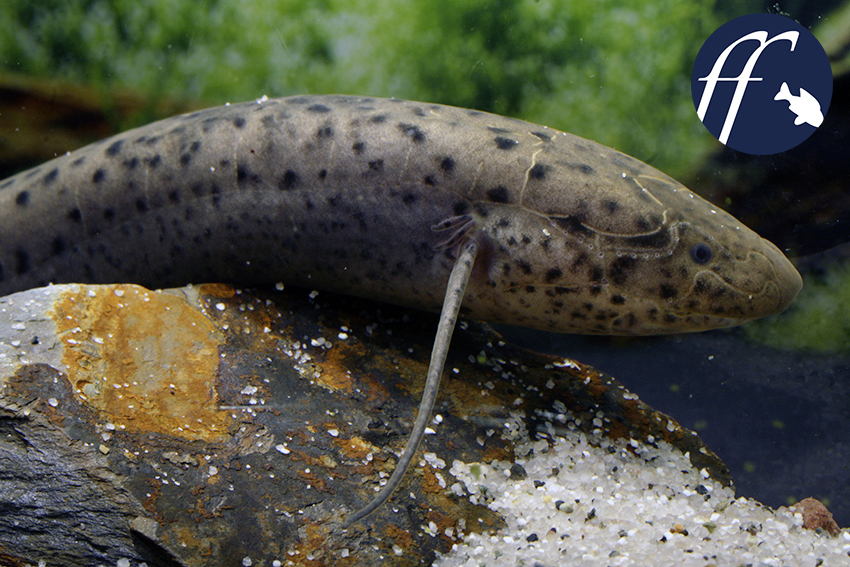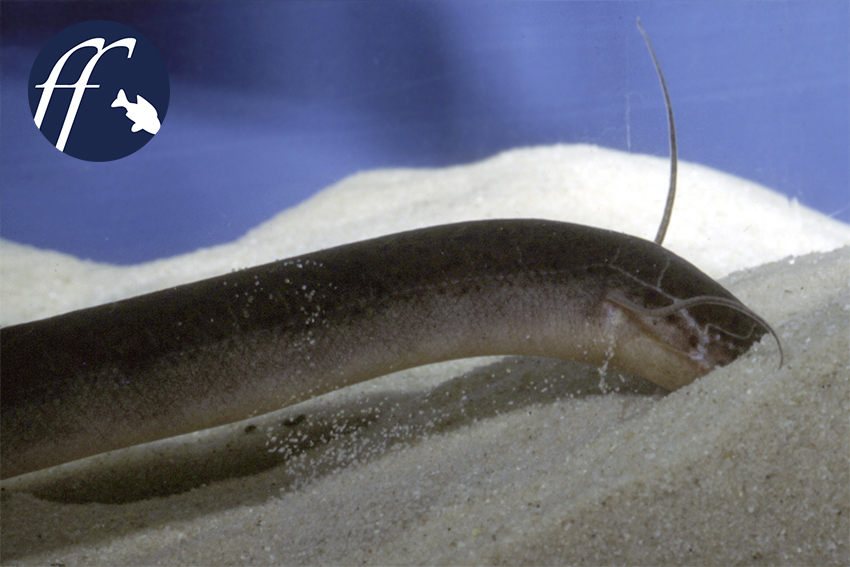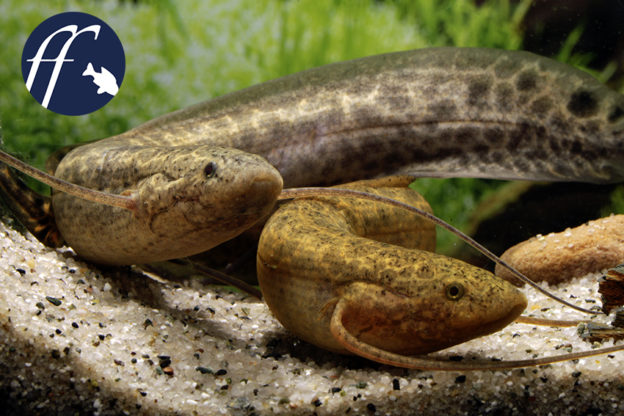

There is a saying that everything that can be done will have been done at some time or other, regardless of whether it makes sense or not. Things are similar in Nature. If it works then it will be implemented, over and over again.
Comparative anatomy indicates that all the creatures in existence have common ancestors, as Nature is very conservative regarding her inventions, once made. We humans have a characteristic feature – the vertebral or spinal column – that is shared by all other mammals as well as by the birds, reptiles, amphibians, and fishes. And hence we belong to the vertebrates. In terms of stages of organization, the fishes occupy a place at the beginning of evolution, i.e. they were the first vertebrates. The amphibians evolved from the fishes, and the reptiles from the amphibians. The reptiles were the ancestors of both the birds and the mammals. In the final analysis, the fact that we humans live on land is down to fishes that, during a period that lasted many millions of years, for some reason or other began to venture onto land. That they did so is beyond dispute. Why they did so remains unknown. And do they still do so today? That will be the topic of this and forthcoming “Franky Friday” blogs.
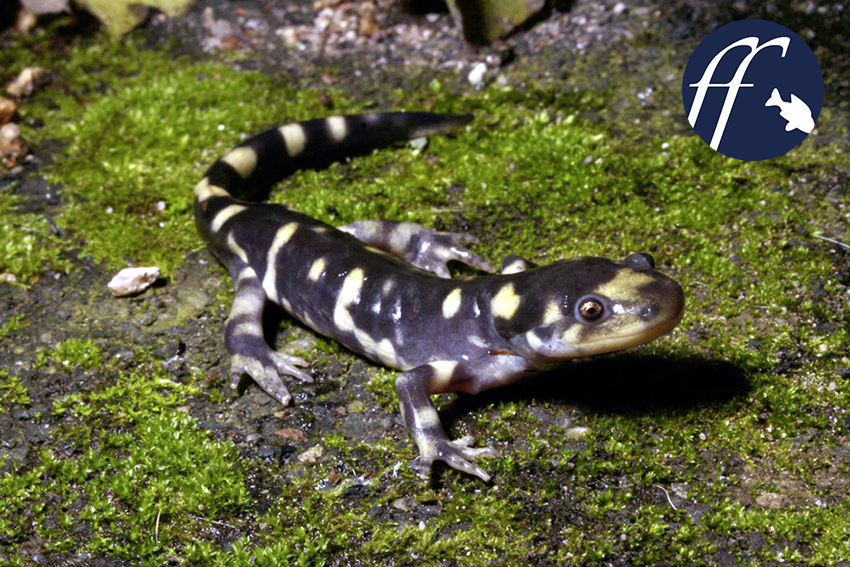
This is a modern salamander of the species Ambystoma marvortium, but the first terrestrial invertebrates probably didn’t look all that frightfully dissimilar.
The first fossil footprints of a quadruped terrestrial vertebrate date from around 397 million years ago. We don’t know what animal they belonged to. The first creature that was able to go on land and which is also known to us was an amphibian, a salamander-like creature with a massive skull, which has been given the name Ichthyostega. Its known remains are around 370 million years old. Amphibians differ from reptiles in that, inter alia, amphibians have to lay their eggs in water, as their eggs lack a protective shell. Fundamentally there is no amphibian species that lays eggs in the sea, even though some species demonstrate a degree of salt tolerance. All species lay their eggs in fresh water. For this reason it is assumed that it was freshwater fishes that were the ancestors of the terrestrial invertebrates. Precisely which cannot be said with any certainty. Comparative anatomy indicates that extinct fishes of the Rhipidistia group were the ancestors of the lungfishes and coelacanths that still exist today, and also of the Ichthyostega.
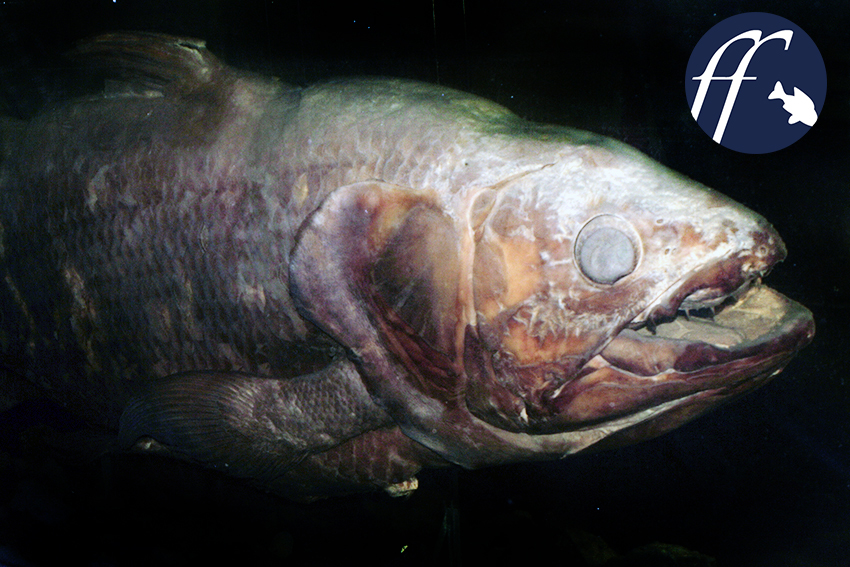
Latimeria chalumnae (preserved specimen), the African Coelacanth
The coelacanths (Latimeria), some of the most famous “living fossils”, live in the sea, usually at depths of between 150 and 700 meters, although they supposedly ascend to 15 meters. Be that as it may, they don’t venture onto land. Nevertheless the study of live coelacanths (there are two species, the African Coelacanth, L. chalumnae, and the Indonesian Coelacanth, L. menadoensis) is incredibly exciting and provides interesting pointers in the still hotly debated discussion among evolutionary biologists regarding whether it was the coelacanths or the lungfishes that are more closely related to the ancestors of the terrestrial quadrupeds. Unfortunately there are no coelacanths kept in any zoo or aquarium anywhere in the world, and they are never seen at all in the trade, so that we have to rely on film material to study these strange creatures, for example that available at http://www.arkive.org/coelacanth/latimeria-chalumnae/ It has to be said that the swimming movements are themselves very special, and the mobility of the fins on their stalks is astonishing. But as far as can be told they don’t correspond at all to the locomotion of quadrupeds. In addition the coelacanths are not the only fishes to have fins on stalks. That is also the case with the bichirs (Polypterus), themselves “living fossils”, which, unlike the coelacanths, live in fresh water. Some species of bichir are currently bred regularly for the aquarium hobby, while others are available wild-caught, likewise the closely related Reedfish (or Ropefish) (Erpetoichthys calabaricus). So we are able to study them in the aquarium.
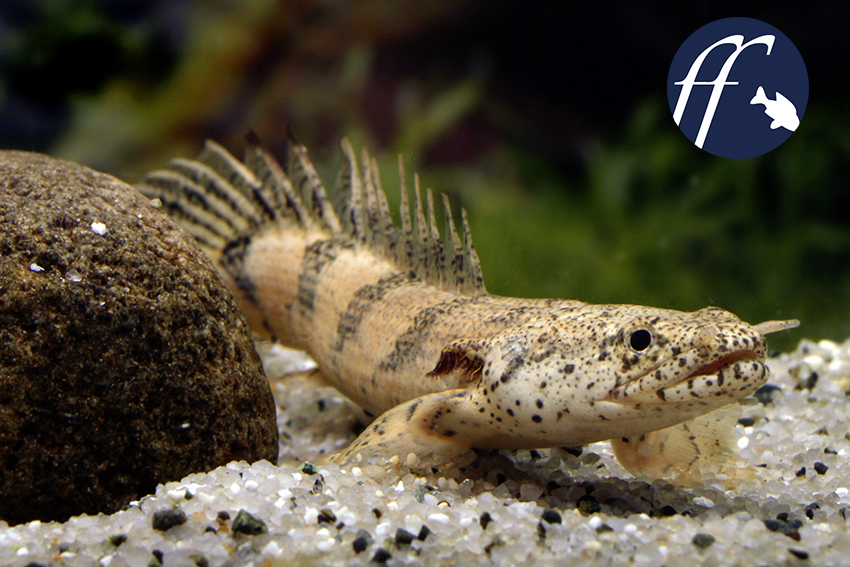
Polypterus endlicherii, a bichir species, juvenile in which the external gills are still visible.
It can then be seen that neither bichirs nor Reedfishes use their limbs like terrestrial creatures. Instead they are elegant swimmers when they aren’t resting (which, however, they do most of the time). Bichirs and the Reedfish exhibit no tendency to venture onto land, although they have all the necessary attributes. Specifically, they breathe largely via lungs, so that obtaining an oxygen supply on land, which is a problem for a gill-breather, as the delicate gill tissues collapse and stick together out of water, presents no difficulties at all for bichirs and the Reedfish. Moreover these fishes don’t have normal scales, but so-called ganoid scales, such that their bodies are enclosed in a type of armor. That too might be potentially useful for traveling on land. And bichirs and the Reedfish can point their heads downwards, towards the bottom, in order to feed. A fish must be able to do this in order to feed on land, as the normal suck-and-snap method used underwater doesn’t work on land because of the considerably lower density of air compared to water.
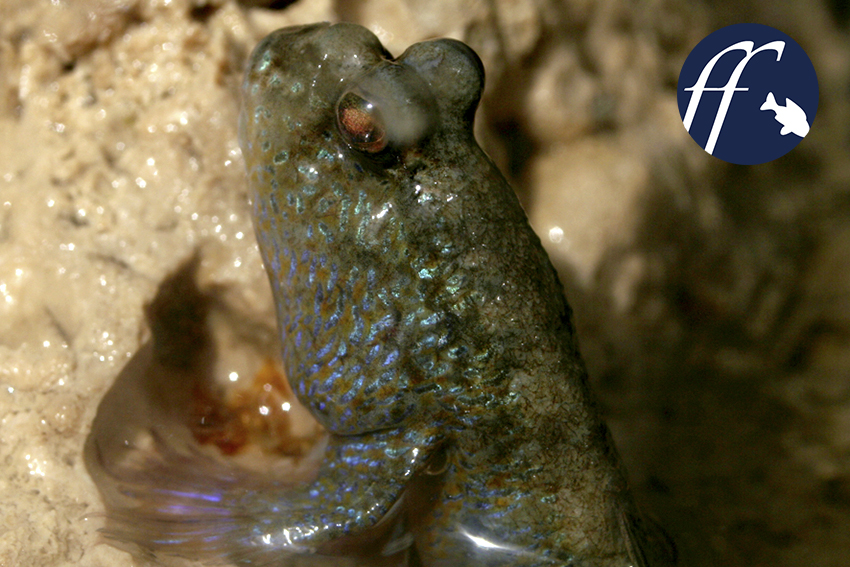
Portrait of a mudskipper (Periophthalmodon septemradiatus), a modern land-going fish. More on mudskippers in one of the forthcoming blogs.
Bichirs are a really ancient group of fishes, with the earliest fossil finds around 100 million years old. But although they are exclusively freshwater fishes that also live in swamps, there is no indication at all that they have ever attempted to venture onto land. Why? Is it because the terrestrial environment was already occupied? Probably not, as there are also very recent fishes that move very well on land and hence are rather successful, for example the mudskippers of the genus Periophthalmus, which will be featured in detail in one of the forthcoming blogs. Today we must stick to the ancient (the technical term is ancestral) fishes, specifically the lungfishes.
Nowadays there are only six species, on three continents. In Australia the Australian Lungfish (Neoceratodes forsteri), in Africa the genus Protopterus with four species, and a further species in South America, the South American Lungfish (Lepidosiren paradoxus). None of these species ventures onto land. But are there any indications from their behavior that they are closely related to the species that do? In the case of the Australian species, no. But the Africans move in a really peculiar way. Their pectoral and anal fins have been modified into thread-like structures. For what purpose remains unknown. But the fishes move them as if they were arms or legs! Protopterus aethiopicus and P. annectens veritably stride across the aquarium, sometimes moving their “arms” like someone swimming the crawl, though the propulsion provided by these “little arms” is undoubtedly negligible.. In the case of Protopterus dolloi, another of the Africans, I have observed something that I have never seen in either of the aforementioned species (unfortunately I have never yet had the opportunity to keep the fourth African species, P. amphibius). African lungfishes have so-called ampullae of Lorenzini all over the body, but particularly on the head region. These are sensory organs that can detect very faint electrical stimuli such as those generated when a muscle moves. Externally the rows of ampullae of Lorenzini look like the stitches on Frankenstein’s Monster. With the aid of these ampullae of Lorenzini P. dolloi can detect a buried Tubifex worm: as soon as the worm moves, P. dolloi sticks its head deep into the sand in search of the buried worm – and simultaneously extends its “arms” straight backwards! A quite unique sight! On the basis of my observations, the South American species hardly uses its arms and legs at all; they are similar to those of the African species, while the Australian Lungfish has broad, flat paddle-fins. However I must add that so far I haven’t had the opportunity to observe the South American species in depth.
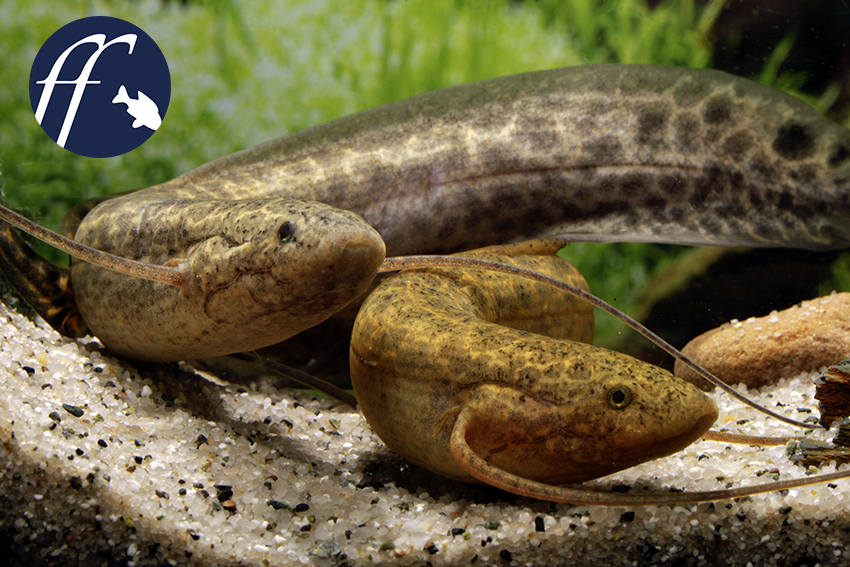
Two young specimens of Protopterus annectens brieni from the Congo.
- Protopterus dolloi aus dem Kongo; die Lorenzinischen Ampullen sind gut zu erkennen.
- Das Tier “taucht” nach einem Wurm. Man beachte die Stellung der Brustflossen.
- Das Tier “taucht” nach einem Wurm. Man beachte die Stellung der Brustflossen.
Above left: Protopterus dolloi from the Congo; the ampullae of Lorenzini are readily visible. Center & right: The fish is “diving” for a worm. Note the position of the pectoral fins.
Although the recent (currently living) lungfishes are actually quite well equipped to come ashore – they breathe using lungs, have stout scales, and can incline their heads downwards – there is no indication of any kind that they use these attributes in order to travel on land. Not even in the event that the waters where they live dry up, when they instead bury themselves and create a cocoon, in which they wait for the rains to come again. Obviously the recent lungfishes aren’t identical with the ancestors of the quadrupeds, and for that reason, equally obviously we can draw only limited conclusions from the behavior of the recent species regarding the extinct ones. But one thing is certain: the lungfishes currently in existence exhibit no noticeable tendency towards switching to a life on land.
Coelacanths, bichirs, and lungfishes, these ancient aristocrats among the fishes, these living fossils, don’t provide us with any answers to the question of why fishes first ventured onto land, even though they are the closest living relatives of the extinct species that first did so 397 million years ago. Their pattern of movements and their anatomy show us that the attributes necessary for going on land can be present without any transition to land-dwelling actually taking place.
In the coming weeks we will look at modern fishes that go on land. Perhaps they can provide us with better answers?!
Frank Schäfer
Additional reading material on bichirs can be found at https://www.animalbook.de
Anzeige






